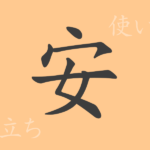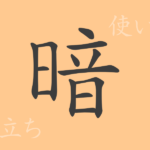“
Characters, through their shapes and historical meanings, serve as keys to conveying culture. The Japanese kanji ‘案’ (An) is no exception. This article delves into the profound world of ‘案’, exploring its origins, meanings, usages, and extending into the idioms and proverbs that incorporate it, showcasing the versatile aspects of this single character.
Origins of 案 (An)
The kanji ‘案’ originated in ancient China. It is composed of ‘木’ (Ki), representing wood, and ‘安’ (An), signifying stability, which originally depicted a woman giving birth, hence initially meaning ‘to think over things calmly at a desk.’ Over time, ‘案’ evolved to encompass the mental states involved in thinking, planning, and proposing ideas.
Meaning and Usage of 案
In modern Japanese, ‘案’ is used in a variety of contexts, primarily to denote ideas, plans, or proposals, and sometimes to express concern or worry. For instance, ‘案を練る’ (An-wo-ne-ru) means to devise a plan, while ‘案じる’ (An-jiru) can mean to worry. In business contexts, it frequently appears in terms like ‘企画案’ (Kikakuan, project proposal) or ‘提案書’ (Teiansyo, proposal document).
Readings, Stroke Count, and Radical of 案
Understanding the structure and meaning of the kanji ‘案’ enhances comprehension of Japanese.
- Readings: On’yomi (on reading) is ‘An’, Kun’yomi (kun readings) are ‘Tukue’.
- Stroke Count: ‘案’ consists of 10 strokes.
- Radical: The radical is ‘木’ (Kihen), related to wood or trees.
Idioms, Phrases, and Proverbs Using 案
Many Japanese idioms, phrases, and proverbs include ‘案’, reflecting its rich imagery. For example:
- 案の定 (An-no-jyou): As expected; turns out as predicted.
- 案外 (Angai): Unexpectedly, surprisingly.
- 案ずるより産むが易し (An-zuruyori-u-muga-yasu-si): It is easier to do something than to worry about it.
Summary of 案
The kanji ‘案’ reflects not just the act of thinking but a breadth of implications about peace and stability, illustrating the richness of Japanese expressions. This exploration of ‘案’ reveals its multifaceted nature, enhancing our understanding of the depth and complexity of the Japanese language. Each character deeply influences our speech, embodying essential elements that shape our communication.
“

























